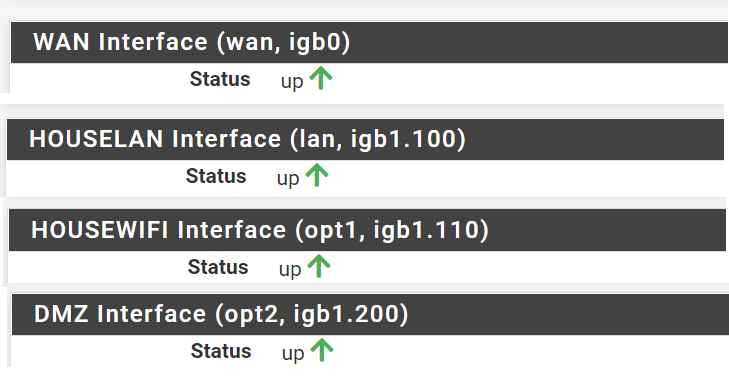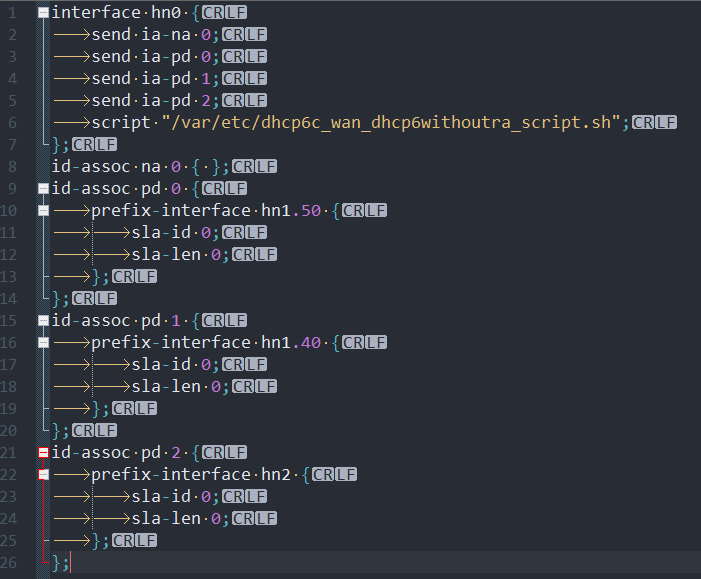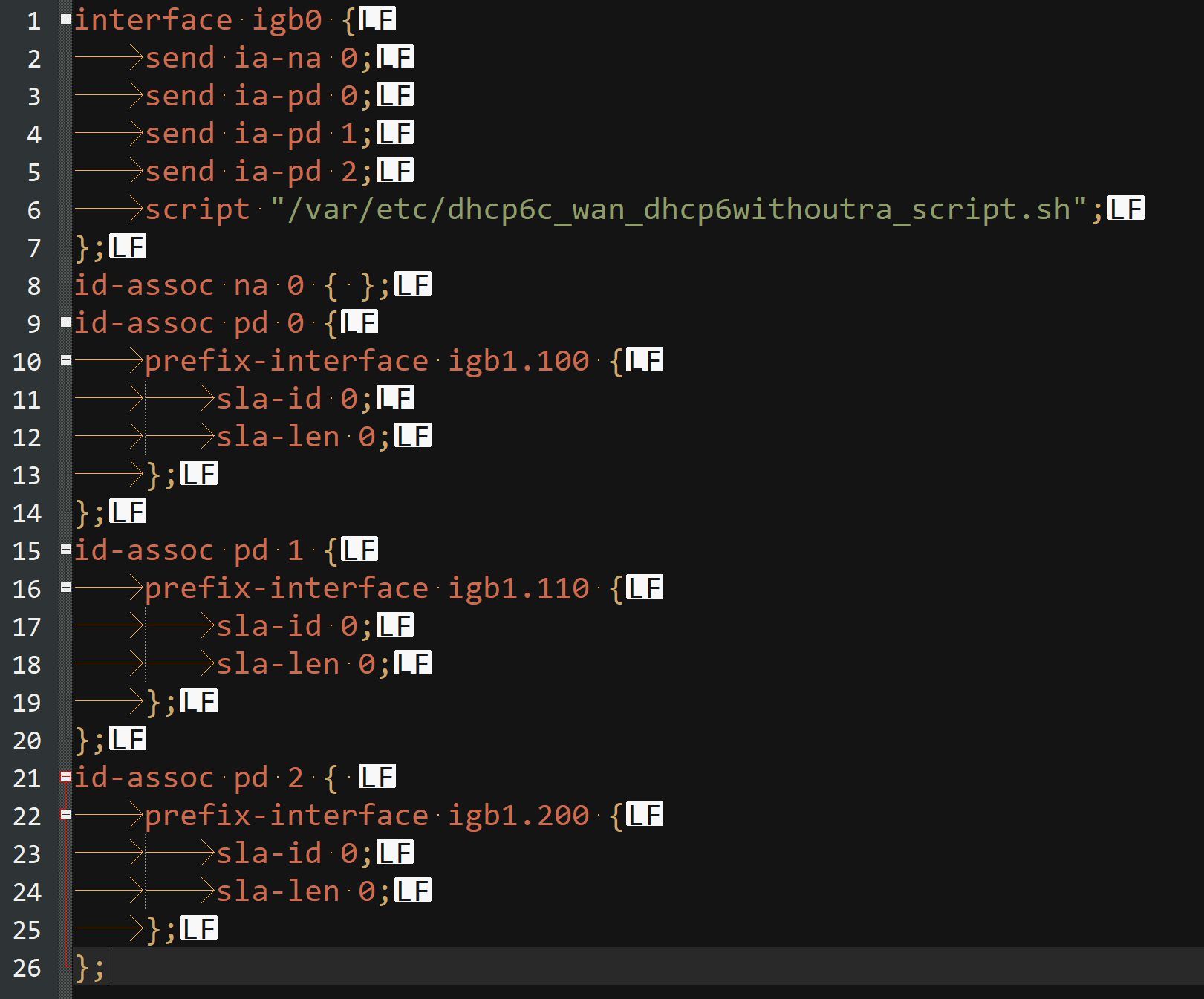Multiple IPv6 Prefix Delegation over AT&T Residential Gateway for pfSense 2.4.5
-
@ttmcmurry I added the table just because it makes the whole thing a little simpler. It’s just crazy that AT&T does all this nonsense trying to prevent me from doing multiple segments with IPv6. Honestly I think SLAAC is a lot easier than stupid DHCPv6
-
It's important to remember SLAAC doesn't register with DNS or DHCP. This is one of the reasons why it isn't the best solution for all situations. It might be fine for home use if the apps you use don't need DNS to find other devices. SLAAC also doesn't support features like DHCP options, which are commonly used in businesses and especially with VOIP systems.
Between lack of configurability, no ability to perform DNS registration, thus making life very difficult for anyone running an Active Directory domain, SLAAC has a place, but it doesn't work great for corporate environments.
Also, be careful when using SLAAC if you're using pfSense for DNS filtering. When I had it enabled, devices were being configured by the AT&T router as the DNS source and was bypassing pfSense.
-
With SLAAC, you point your DNS at the consistent address, which is often based on the MAC address. On the other hand, if you use DHCPv6, you won't be able to use Android devices, as for some stupid reason it's not supported. I have never been able to determine any reason for it not to be supported, other than the developer doesn't like it. His arguments against it could also apply to SLAAC.
-
@JKnott
I suppose I have 2 observations:-
Android devices will still work on the IPv4 stack. If Managed DHCPv6 mode is enabled, you're correct, those will not get an IPv6 address.
-
With respect to using pfSense to perform DNS filtering while using stateless autoconfig/Assisted mode/SLAAC.
When using DHCPv6 in this manner, when pfSense's IPv6 WAN IP is dynamic, problems become apparent quickly. Since a static IPv6 WAN address is not available to configure in pfSense's DHCPv6 RA DNS Server list, what happens is the RA is passed on from the AT&T RG. Therefore in this configuration, DNS will bypass pfSense..
If you're not using pfSense to filter/route DNS toward a filtering provider, then this isn't a concern and go stateless and you're probably fine with allowing AT&T to monitor where you go on the internet.

Yes, a configuration paradox exists because Google won't support DHCPv6 on Android. The addressing problems are resolved when using DHCPv6 in Managed mode. However, Android devices cannot be allocated IPv6 addresses as a result. In the end the same underlying goal is achievable, albeit without direct IPv6 support.
It's about compromising & determining which compromise covers the majority of your needs.
Of course I would love to be proven wrong. The moment I set DHCPv6 for Stateless or Assisted, my subnets get addresses from the AT&T RG. If that's a configuration error on my side (firewall rule on wan interface??) I'd love to fix that and update this doc!
-
-
To anyone that comes to this thread I have made a GitHub to have all the changes that have been made throughout this thread. Also for easier reading. [all input is welcome]
@ttmcmurry I hope this is okay, I made sure to give you 190% credit as this is your hard work.
-
A couple of notes:
- On the WAN interface settings page, setting the prefix size to /60 has no effect on dhcp6c or what the dhcp6c client requests from the ISP. The reason for doing that is to tell the web UI what range of prefix IDs to allow on the LAN configuration pages. If you leave it at /64, it will only allow '0', and it won't let you set that on more than one interface. You're setting it to /60 to trick the web UI validator, not because you want a /60 from your ISP.
- With this in mind, although you can use arbitrary values for
ia_pdin your config file, you will want to stick to 0–8 for prefix IDs so that they will validate in the UI.
-
@deet have you tested this effect?
in 2.4.5, the UI doesn't allow other interfaces to track a wan interface to use a metric higher than 0 when the wan is set to /64.
It was necessary to set both the script and the corresponding interface in the UI to use the same prefix id.
I believe there's a DHCP Service dependency on the interface in the UI to use the tracked interface prefix specified there. Said another way, I do not believe the DHCP v6 Service evaluates a dhcp.conf file if the WAN's DHCP Override contains a conf; it has to use the value specified in the interface's UI.
If this behavior has changed in "p1" - could you provide confirmation and the updated steps for others to follow?
-
@lilchancep - thank you. Ever since the netgate forum rules change, it became difficult to keep this up to date. I have been waiting for 2.5 to come out to make any significant overhaul, but would end up in the same place, unable to update it after a few hours.
I've starred the page you created in github. :)
-
@ttmcmurry said in Multiple IPv6 Prefix Delegation over AT&T Residential Gateway for pfSense 2.4.5:
@deet have you tested this effect?
I am describing my own findings, so yes.
I was initially confused about the need to set the prefix to /60 in the WAN settings before setting the override file path. "Why would it matter what the prefix length is set to, if we're just going to override it in the .conf file?" I wondered. So I tried setting the WAN prefix length to different values to see what would happen.
I found that the .conf override file is what governs the behavior of dhcp6c, not the value in the field, "overriding" indeed.
Setting the WAN prefix length to /60 does not, therefore, have any bearing on what prefix dhcp6c requests.
But the pfsense web GUI does use that value when validating the prefix IDs on the LAN pages. If you leave it at /64, the only valid prefix ID is 0. The validator looks at /64 and calculates only one available prefix ID. By setting the WAN prefix length to /60, however, the validator calculates a range of up to 16 IDs. (Of which 8 are actually available, but that's a gateway limitation, not an IPv6 thing.)
So like I say, setting it to /60 matters not because it tells dhcp6c to do anything relevant, but because without it, the pfsense web GUI validator won't let you set the values you need to set in the LAN pages.
in 2.4.5, the UI doesn't allow other interfaces to track a wan interface to use a metric higher than 0 when the wan is set to /64.
Right.
It was necessary to set both the script and the corresponding interface in the UI to use the same prefix id.
With this method, yes. But ordinarily, no; "ia_pd" in the .conf file doesn't have to be anything in particular; it is purely an index for configuration purposes. And, ordinarily, the prefix ID in the GUI doesn't have to be anything particular, either, except that it needs to be within a range valid for the delegated prefix, because ordinarily it would end up appended to the delegated prefix being tracked. These are, ordinarily, separate values unrelated to each other.
For example, if this were Comcast, and we'd been properly delegated a /60, we could put 'f' as the ID in one interface and '9' as the ID in another, and each network would get a prefix ending in 'f' and '9' respectively. Thus can this field be set to anything we want as long as it results in a valid prefix.
But because of the way we're fitting square pegs into round holes, we need the ia_pd in the .conf file to match the "prefix ID" in the GUI. Not because it will be appended to the delegated prefix as usual — because the delegated prefix we get will go straight to the tracking interface. Rather, we are using that field to tell pfSense which /64 prefix (referring to the ia_pd set in the conf file) goes to which interface (which is also indicated in the conf file).
In practice, the prefix we get will not be the usual <delegated /60 prefix> + <"prefix suffix" to form a complete /64 prefix>, but rather <whatever /64 prefix is assigned to us by the gateway>.
Apologies if I am trying to dig myself out of a hole with this explanation. It makes sense the way I'm reading it but I get that it's confusing and I am probably not being clear. It's just, after wondering why setting /60 would matter in the GUI when we were using a conf override file (and the answer is, for GUI-related reasons only), my next question was why the prefix ID set in the GUI would have any bearing, since the /64 being delegated has no more bits available for any suffixes to be appended. The answer is, the ID is not actually being appended as usual. Instead, through this method, we are setting not a "prefix suffix" but rather telling pfsense which ia_pd dhpc6c should associate with the interface.
I believe there's a DHCP Service dependency on the interface in the UI to use the tracked interface prefix specified there.
The dependency is in how the pfsense GUI works, not in the DHCP service.
Said another way, I do not believe the DHCP v6 Service evaluates a dhcp.conf file if the WAN's DHCP Override contains a conf; it has to use the value specified in the interface's UI.
Sort of. The .conf file does indeed take full control of what actually happens to all interfaces. But we have to do this GUI stuff to make sure the GUI matches what dhcp6c is doing.
If this behavior has changed in "p1" - could you provide confirmation and the updated steps for others to follow?
The steps are the same! We're doing all the right things. My comments are as much for my own future reference as for anything. "Wait why does it matter what we do in the GUI if we're overriding everything in the conf file? Oh, it's because we need the GUI to match what the conf file is doing, and we have to fudge some things in order for that to happen." That's all.
Clear as mud?
-
@deet
Clear as mud. I just installed 2.5 and will get around verifying all of this when I have some spare time. :)At least we understand each other!
-
So, I updated to 2.5.0 and attempted to implement this hoping I could get ipv6 running on my individual internal vlans. That being said, I setup the script as above and it looks something like this:
interface igb0 { send ia-na 0; send ia-pd 0; send ia-pd 1; send ia-pd 2; request domain-name-servers; request domain-name; script "/var/etc/dhcp6c_wan_script.sh"; }; id-assoc na 0 { }; id-assoc pd 0 { prefix-interface igb1.100 { sla-id 0; sla-len 0; }; }; id-assoc pd 1 { prefix-interface igb1.110 { sla-id 0; sla-len 0; }; }; id-assoc pd 2 { prefix-interface igb1.200 { sla-id 0; sla-len 0; }; };However, I WAN is the only interface to pull a ipv6 address, and I am seeing this in the logs:
dhcp6c[64417]: unexpected interface (1)been having some trouble with ipv6 after updating to 2.5.0 but you're script has given me a little bit of progress. Any help would be appreciated, and if you need more details please let me know and I'll update as soon as possible.
-
@cbennett2010 if you go to Status > interfaces, do the interface names all exist and match?
-
@deet Yes they match. here's whats shown under status below:

-
In your example, WAN interface igb0 is calling
script "/var/etc/dhcp6c_wan_script.sh";Have you tried using the code from the first post instead?
script "var/etc/dhcp6c_wan_dhcp6withoutra_script.sh";I recently moved to 2.5 and I opted to not have my WAN interface request domain-name and domain-name servers in my ipv6 script. That said, I specify these values elsewhere.
My current config is listed below. Maybe that will help. Also, dhcpd is sensitive to syntax, tabs, etc. I'll also post a screenshot from notepad++ with all characters displayed, perhaps that will help.
interface hn0 { send ia-na 0; send ia-pd 0; send ia-pd 1; send ia-pd 2; script "/var/etc/dhcp6c_wan_dhcp6withoutra_script.sh"; }; id-assoc na 0 { }; id-assoc pd 0 { prefix-interface hn1.50 { sla-id 0; sla-len 0; }; }; id-assoc pd 1 { prefix-interface hn1.40 { sla-id 0; sla-len 0; }; }; id-assoc pd 2 { prefix-interface hn2 { sla-id 0; sla-len 0; }; };
-
@ttmcmurry Thank you for the reply while I try to figure this out. So I made the modifications to change the script that is running, and verified the Text Syntax:

but alas still seeing the same error:
Feb 28 16:41:46 dhcp6c[23870]: Sending Solicit Feb 28 16:41:46 dhcp6c[64417]: unexpected interface (1)I'm beginning to wonder if AT&T really only did allocate a /64 to me. Because looking at my RG device and seeing what is allocated to it, I see this:
Global Unicast IPv6 Address ****:****:****:7a90::1 Link-local IPv6 Address fe80::8a96:4eff:fe89:6d70 IPv6 Addressing Subnet (including length) ****:****:****:7a90::/64 IPv6 Delegated Prefix Subnet (including length)And this is the address that I see on my WAN:
****:****:****:7a90:92e2:baff:fe80:c6f8So not sure why i'm not seeing a Delegated Prefix Subnet on my AT&T RG.
Thanks for all the help so far!
-
On your AT&T RG, what does it say for your WAN connection (Settings -> Broadband -> Status)?
On mine, I have IPv6 Internet Connection with the following data:
IPv6 Internet Address: 2001:506:xxxx:xxxx::1
IPv6 Default Gateway: fe80::xxxx:xxxx:xxxx:xxxx
IPv6 Delegated Prefix: 2600:1700:xxxx:xxxx::/60Also under Settings -> LAN -> Status, there is IPv6 Status:
LAN Status: Up
Link Local Address: fe80:xxxx:xxxx:xxxx:xxxx
Delegated Address: 2600:1700:xxxx:xxxx::1Where the delegated address is inside the IPv6 delegated prefix range in the section above.
Check DHCP (Settings -> LAN -> DHCP) under DHCP6 Configuration:
Prefix Delegation: Enabled (checkmark)
Address Assignment: Enabled (checkmark)Lastly ensure IPv6 is enabled in the LAN (Settings -> LAN -> IPv6):
IPv6 LAN Enabled: Enable (checkmark)
... the important takeaways are the broadband status page shows the IPv6 Delegated prefix is both present and has a /60 at the end. If the RG is set up correctly as above or if you've made changes to these settings, try a reboot. If it still doesn't get a /60 you may need to talk to AT&T and ask why that is the case.
As far as I'm aware, all AT&T RGs get a /60 and the device itself needs and reserves multiple /64s from the /60 just for its base functionality to work (Guest Wifi, U-Verse TV, Internet Phone).
-
@ttmcmurry said in Multiple IPv6 Prefix Delegation over AT&T Residential Gateway for pfSense 2.4.5:
IPv6 Default Gateway: fe80::xxxx:xxxx:xxxx:xxxx
No need to hide a link local address, as it's unreachable from beyond the local link.
-
Habit from work. :) Policy is always obscure IP Addresses.

-
@ttmcmurry Yeah when I log into my RG the only thing I see is this:

So nothing shows up under the ipv6 delegated prefix subnet. And I checked the other settings, and rebooted the RG.I spoke on chat with AT&T which I feel that their knowledge of ipv6 is probably even less than mine, not that its their fault, i'm sure its just not many people really deal with it that much. But they stated, and their manager stated that i'm only allocated a /64, and if I wanted more I needed to pay $15 dollars a month for static ip's to get a larger allocation. which seems a little crazy, but I guess i'm kinda stuck unless I go the RG bypass route and set pfsense as the primary connection to actually see what i'm getting from the AT&T side. Again thanks for the help, just not sure why ipv6 is completely down for me now after updating to 2.5.0 because before I could at least get 1 ipv6 network running with tracking the wan interface, but now I get nothing. I'll keep plugging away on my end until I figure out something.
-
@ttmcmurry Ok so, I made a little bit of progress, there is something definitely different with pfsense. So I disabled everything IPv6 within pfsense, and ssh'd into the box and killed all dhcp6c processes, I then proceeded to manually run the dhcp6c client on my WAN interface with the following command:
/usr/local/sbin/dhcp6c -D -c /usr/local/etc/rc.d/att-rg-dhcpv6-pd.conf igb0when I did that, amazingly I was able to pull ipv6 addresses on all my interfaces as was originally expected. However, now that I have everything turned off, the DHCP6 servers and RA's aren't on, but still, a little bit of progress.
Any thoughts of where to look next, i'm just poking around in the dark at this point.
Thanks Again!